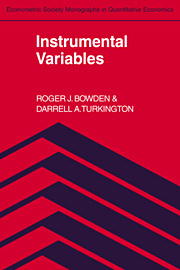3 - Instrumental variables and nonspherical disturbances
Published online by Cambridge University Press: 05 January 2013
Summary
Introduction
In presenting the basic theory of instrumental variables estimation, we assumed that the error structure was spherical; that is, the disturbance terms ut have a common distribution with variance σ2 (homoscedasticity) and are also serially uncorrelated in the sense that ɛut ut-r = 0 for r≠0. Expository convenience aside, certain models do indeed fall into such a framework, and we discussed the errors-in-variables structure as an example. However, the sphericality assumption is less satisfactory in other contexts. Indeed, in some instances, the very necessity for an IV approach arises out of a nonspherical error structure. In the present chapter we shall explore some of the implications of nonsphericality in the disturbances, utilizing for the purpose models taken from time series analysis that involve serial correlation and a class of models exhibiting heteroscedasticity.
We commence with a general discussion of different definitions of the IV estimator where the error distribution is nonspherical; specifically, the covariance of the disturbance vector is a nondiagonal matrix of constants. We have already touched on this context in Section 1.2, where the estimator (1.26) associated with the minimand (1.25a) was suggested as appropriate for the nonspherical case. We shall, in the present chapter, further explore the nature and properties of this estimator. Initially, however, we shall find it profitable to take a rather different route to its derivation, for by doing so a second type of estimator is suggested. We are able to generate two generic kinds of estimator, the one interpretable as an ordinary least-squares analog, the other as an Aitken analog. The efficiency comparison of these two approaches is explored.
- Type
- Chapter
- Information
- Instrumental Variables , pp. 67 - 97Publisher: Cambridge University PressPrint publication year: 1985
- 2
- Cited by



